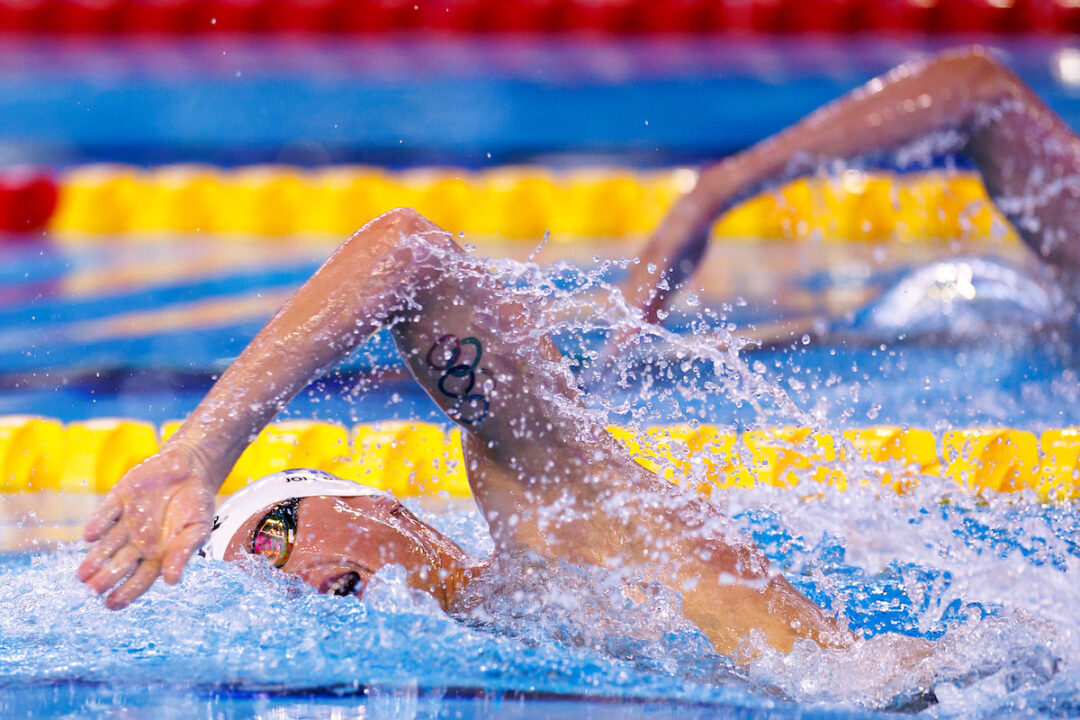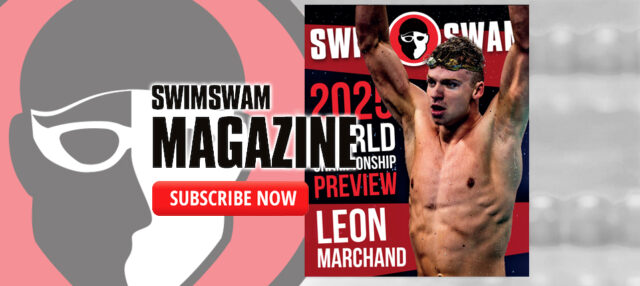Looking to upgrade your catch? Here are seven tips for developing a stronger freestyle catch.
The freestyle catch is a crucial phase/part/section of the freestyle stroke.
We plant our hand and forearm in the water, engage the lats and shoulders, and launch ourselves across the length of the pool.
While it seems straightforward enough—catch the water, swim through the water—a big league catch (ha! Baseball pun!) requires an optimal range of motion, technique, and strength.
A soggy catch is also one of the most common freestyle stroke errors, with one study of collegiate swimmers finding that 61.3% exhibited a dropped elbow at the beginning of the pull motion (Virag et al., 2014).
In this little collection of tips for a stronger freestyle catch, I’ll break down some of my favorite ways to refine your catch for more speed in the water.
Let’s dive in.
Tips for a Stronger Freestyle Catch
Ways to power up your freestyle catch include:
- Increase range of movement
- Front sculling
- Cable pulls
- Resisted swimming
- Drills
- Technique cues
- Swim with intent
Next, we will look at each tip in more detail and offer some instructions for getting the most out of each tip.
Increase range of movement
Let’s start off with the most basic aspect of a powerful freestyle catch, because the fundamentals never go out of style.
And that’s range of motion!
One of the most common roadblocks to a high elbow catch is not having the shoulder and elbow mobility to get into a high elbow position.
An excellent all-around stretch for swimmers, and the best way to target the catch are hinged freestyle arm swings with a high elbow.
How to do it:
- Hinge forward at the hips, torso at a 30-45-degree angle, keeping your back flat and core engaged
- Let the arms hang naturally and then start to swing them in alternating pattern, one arm forward, one arm backward
- Add a slight bend in the elbow to mimic the catch
- As you improve, increase the bend in the elbow, working to get those fingers pointed to the floor
- Keep the movements smooth and controlled, allowing the shoulder, scaps, and elbows to loosen and warm up
That’s about as simple and specific as it gets.
Tack on 20-30 swings, for 2-3 rounds, during your pre-swim dryland activation and you’ll find that the catch is open for business when you dive into the water.
Front sculling
Sculling is an essential tool for swimmers to help improve feel for the water and learn how to catch and cup more water with each stroke.
It’s especially great for hitting that catch and working your ability to not only get into position, but also to grab more water.
Front sculling is my go to for the catch.
How to do it:
- Strap on your favorite swim snorkel and push off.
- Set the hands so that they are just outside of shoulder width.
- Move the hands in a tight figure eight pattern.
- Descend the hands slightly, keeping the elbows higher than the wrists.
Drop some sculling into your warm-up or pre-set to prime a strong, catchy catch.
Cable pulls
Resistance bands are one of the standard dryland accessories for swimmers. The portability and accessibility are hard to beat. And they can also be helpful for helping “groove” the catch.
But for developing a truly powerful catch outside of the water, hit up a cable machine.
Resistance bands provide progressive resistance, generating more resistance the further you pull away. Which means the catch phase gets the least amount of resistance. Cables are 100% resistant from the outset.
Add resistance
We’ve covered how to strengthen the catch outside of the water. How about in the pool, too?
Welp, let’s grab our choice of resistance swim training gear and do some strength development with the catch while swimming.
Tools like a swim parachute, resistance tubing, or even a power tower can be used to fire up a stronger catch.
Once you’ve got the technique dialed in, and the elbow be-high, resisted swimming can help you generate more power in the catch.
Start off with 25s with low to medium resistance to get a sense of how the added resistance encourages your body to “self-organize” to overcome resistance and exert more power in the catch phase.
With resisted swimming, you can use your regular freestyle stroke (progressively adding resistance, obviously, so don’t be Johnny Broken Shoulders by fully loading the rack on day one) or even your choice of catch-centric drills to promote more strength and power in the catch phase.
Speaking of drills…
Drills
Freestyle drills are essential for developing a stronger catch as they allow swimmers to isolate the mechanics and technique and give it their full, undivided attention.
While just about every freestyle drill can be used to zero in on the catch, my top catch-heavy drills include:
Closed fist drill. Closed fist freestyle—literally balling your hands up and relying on the forearm to “catch” the water—supports a better catch by removing your fingers as paddles. This drill encourages swimmers to get the forearm into a vertical position more quickly.
Long dog drill. Long dog drill promotes an elongated and deliberate catch and pull. I find the set-up into the catch is easier by recovering under the water. Pair with a swim snorkel so that you can really get a full sense of what a clean and full catch feels like.
To maximize these freestyle drills, pair with regular swimming (e.g. 25 drill, 25 swim) to transfer that smoother and stronger catch to your stroke.
Technique cues
Cues are short, small action phrases or words that help us to focus on properly executing a movement.
I’ve discussed the power of performance cues on helping maintain a steely focus when racing and sticking to a race strategy, but in today’s case, we are looking at swimming with a high-quality catch.
You could tell yourself something like: “Swim with a high elbow catch ya big goober!” or you could try something shorter, to the point, and a little less wordy.
Some ideas for technique cues swimmers can use to achieve and maintain a high elbow catch include:
- Reach over the barrel
- Fingers to the bottom
- Elbow first
- Forearm catch
Start by adding the cues during lower intensity swimming (e.g. warm-up, drills, aerobic sets) to refine and automate a more technically efficient catch.
Swim with intent
One of the realities of swimming, and trying to swim well, is that every yard or meter is an opportunity to swim efficiently and awesomely.
If mastering the catch is important to you, make it a central focus of your training.
From the time you dive into the water, during the main set, all the way through the warm-down, swim with a high elbow and a strong catch.
Swimmers often make the mistake of only swimming with an eye towards mastering a specific technical section of their freestyle stroke when doing drill or swimming slow.
But technique improvement happens fastest when we work towards efficient swimming when going slow, fast, tired, energized, and everywhere in between.
Wrapping Things Up
Ultimately, building a stronger freestyle catch comes down to mastering the basics, building strength in and out of the water, and using a “catch-first” mindset in the water.
Each lap is an opportunity to refine that bad boy, so try out the tips and drills in this guide and remember that improvement adds up over time.
Catch that water, launch yourself forward towards faster times in the pool, and happy swimming!
ABOUT OLIVIER POIRIER-LEROY
Olivier Poirier-Leroy is a former national-level swimmer, author, swim coach, and certified personal trainer. He’s the author of YourSwimBook, a ten-month logbook for competitive swimmers.
 He’s also the author of the best-selling mental training workbook for competitive swimmers, Conquer the Pool: The Swimmer’s Ultimate Guide to a High-Performance Mindset.
He’s also the author of the best-selling mental training workbook for competitive swimmers, Conquer the Pool: The Swimmer’s Ultimate Guide to a High-Performance Mindset.
It combines sport psychology research, worksheets, anecdotes, and examples of Olympians past and present to give swimmers everything they need to conquer the mental side of the sport.
Ready to take your mindset to the next level in the pool?
Click here to learn more about Conquer the Pool.


I am coming at swimming by way of starting water polo a few years ago. All of these are great tips to help get faster and I also appreciate your clever writing style. I am looking up your book Sir!